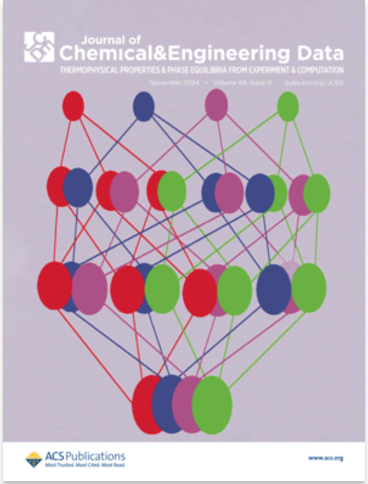Phase II trial of BXCL701 and pembrolizumab in patients with metastatic pancreatic ductal adenocarcinoma (EXPEL-PANC): Preliminary findings.
IF 2.1
3区 工程技术
Q3 CHEMISTRY, MULTIDISCIPLINARY
Journal of Chemical & Engineering Data
Pub Date : 2024-06-10
DOI:10.1200/jco.2024.42.17_suppl.lba4132
引用次数: 0
Abstract
LBA4132 Background: Pancreatic ductal adenocarcinoma (PDAC) has limited therapeutic options and is thought to be a “cold” tumor that does not respond to immunotherapy, due to a tumor microenvironment (TME) consisting of a desmoplastic stroma and poor T cell infiltrate. BXCL701 is an oral synthetic dipeptide that competitively inhibits dipeptidyl peptidases DPP4, DPP8, DPP9 and fibroblast activation protein (FAP). BXCL701 exerts antitumor activity via inhibition of DPP8/9, which is associated with induction of proinflammatory cytokines, as well as inhibition of FAP, which disrupts tumor-stromal interactions. Preclinical xenograft models demonstrate synergy between BXCL701 and PD-1 blockade, reducing tumor growth and promoting an increase in intratumoral CD4+ and CD8+ T cells, macrophages and NK cells, with induction of host-protective immunity. Methods: This is a phase II trial of BXCL701 in patients with metastatic PDAC (mPDAC) following progression on 1 line of treatment for advanced disease and amenable to serial biopsies. BXCL701 is administered at 0.2 mg PO BID days 1-7 and 0.3 mg BID days 8-14 during cycle 1 (21 days) followed by 0.3 mg BID days 1-14 every 21 days in all other cycles, given with pembrolizumab 200 mg IV every 21 days (all cycles). The primary objective is to determine the 18-week progression-free survival rate (PFS18weeks). We estimate that historical 2nd-line PFS18weeks is 30% or less; using a Simon’s two-stage (minimax) design, a type I error rate of 0.05 and power of 80% if the true rate is 50%, we will need 19 patients in stage 1 and 20 in stage 2 (39 total). There is a safety lead-in phase of 6 patients. We plan to enroll 43 patients to account for a predicted 10% drop out of unevaluable patients. Correlative pharmacodynamic studies include imaging mass cytometry to examine 36 markers of the PDAC TME in tissue biopsies, as well as blood-based analyses of KRAS circulating tumor DNA, circulating markers of fibrosis, and IL-6. Enrollment began in Q3 2023 (NCT05558982). Results: Six patients have enrolled, 3 women and 3 men, median age 57.5 (range 37-80). One patient was progression-free at 18 weeks and 1 patient had stable disease (SD) at 9 weeks, not yet evaluable for the 18-week landmark. Objective response rate is 16% and disease control rate is 50% (RECIST: 1 partial response, -41%, and 2 patients with SD, -18% and 0%). Three patients had significant reductions in CA19-9 from baseline (-100%, -73%, and -97%). Median PFS and overall survival have not been reached (NR, 95% CI 1.45 months-NR and 0.92 months-NR, respectively). There have been no serious treatment-related safety events. The safety lead-in will complete after the next patient completes the 6-week safety window (1 patient was unevaluable). Conclusions: BXCL701 plus pembrolizumab is well-tolerated and shows early signs of potential clinical activity in patients with mPDAC refractory to chemotherapy. Clinical trial information: NCT05558982 .BXCL701和pembrolizumab治疗转移性胰腺导管腺癌患者的II期试验(EXPEL-PANC):初步研究结果。
LBA4132 背景:胰腺导管腺癌(PDAC)的治疗方案有限,而且被认为是一种 "冷 "肿瘤,由于肿瘤微环境(TME)由脱瘤基质和贫乏的T细胞浸润组成,因此对免疫疗法没有反应。BXCL701 是一种口服合成二肽,可竞争性抑制二肽基肽酶 DPP4、DPP8、DPP9 和成纤维细胞活化蛋白(FAP)。BXCL701 通过抑制与诱导促炎细胞因子相关的 DPP8/9 以及抑制破坏肿瘤基质相互作用的 FAP 发挥抗肿瘤活性。临床前异种移植模型证明了 BXCL701 与 PD-1 阻断之间的协同作用,可降低肿瘤生长,促进瘤内 CD4+ 和 CD8+ T 细胞、巨噬细胞和 NK 细胞的增加,并诱导宿主保护性免疫。研究方法这是一项 BXCL701 的 II 期试验,用于晚期疾病一线治疗进展后的转移性 PDAC(mPDAC)患者,并可进行连续活检。BXCL701在第1周期(21天)第1-7天静脉滴注0.2毫克,第8-14天静脉滴注0.3毫克,随后在所有其他周期每21天静脉滴注0.3毫克,第1-14天静脉滴注0.3毫克,同时每21天静脉滴注200毫克pembrolizumab(所有周期)。主要目标是确定18周无进展生存率(PFS18weeks)。我们估计历史上二线患者的 18 周无进展生存率为 30% 或更低;采用西蒙两阶段(minimax)设计,I 型误差率为 0.05,如果真实比率为 50%,则功率为 80%,我们在第一阶段需要 19 名患者,第二阶段需要 20 名患者(共 39 名患者)。安全先导阶段需要 6 名患者。我们计划招募 43 名患者,以考虑到预计有 10% 的无效患者退出。相关药效学研究包括成像质谱检测组织活检中 PDAC TME 的 36 个标记物,以及基于血液的 KRAS 循环肿瘤 DNA、循环纤维化标记物和 IL-6 分析。2023年第三季度开始入组(NCT05558982)。结果:6名患者入组,其中3名女性,3名男性,中位年龄为57.5岁(37-80岁)。1名患者在18周时无病情进展,1名患者在9周时病情稳定(SD),尚未进行18周的标志性评估。客观反应率为 16%,疾病控制率为 50%(RECIST:1 例部分反应,-41%;2 例 SD 患者,-18% 和 0%)。3名患者的CA19-9较基线明显降低(-100%、-73%和-97%)。中位 PFS 和总生存期尚未达到(NR,95% CI 分别为 1.45 个月-NR 和 0.92 个月-NR)。没有发生严重的治疗相关安全事件。在下一位患者完成为期 6 周的安全窗口期后,安全先导期将结束(1 位患者无价值)。结论BXCL701联合pembrolizumab耐受性良好,在化疗难治的mPDAC患者中显示出潜在临床活性的早期迹象。临床试验信息:NCT05558982 .
本文章由计算机程序翻译,如有差异,请以英文原文为准。
求助全文
约1分钟内获得全文
求助全文
来源期刊

Journal of Chemical & Engineering Data
工程技术-工程:化工
CiteScore
5.20
自引率
19.20%
发文量
324
审稿时长
2.2 months
期刊介绍:
The Journal of Chemical & Engineering Data is a monthly journal devoted to the publication of data obtained from both experiment and computation, which are viewed as complementary. It is the only American Chemical Society journal primarily concerned with articles containing data on the phase behavior and the physical, thermodynamic, and transport properties of well-defined materials, including complex mixtures of known compositions. While environmental and biological samples are of interest, their compositions must be known and reproducible. As a result, adsorption on natural product materials does not generally fit within the scope of Journal of Chemical & Engineering Data.
 求助内容:
求助内容: 应助结果提醒方式:
应助结果提醒方式:


